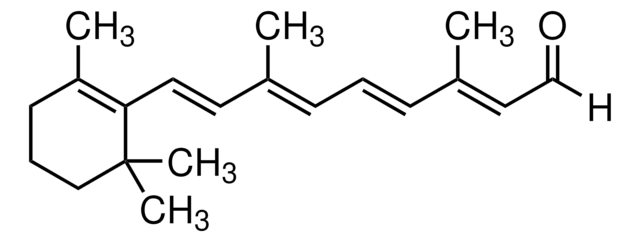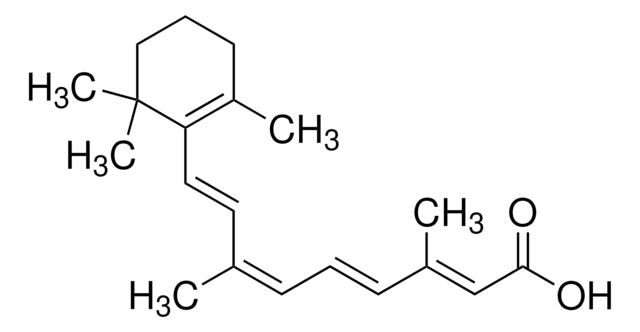87809
Retinyl propionate
≥98.0% (sum of isomers, HPLC), ~2500 U/mg
Synonym(s):
Vitamin A propionate
About This Item
Recommended Products
biological source
synthetic
Assay
≥98.0% (sum of isomers, HPLC)
form
liquid
specific activity
~2500 U/mg
contains
BHT as stabilizer
impurities
~5% cis-isomers
color
green-yellow to very dark green-yellow
yellow to very dark yellow
storage temp.
2-8°C
SMILES string
CCC(=O)OC\C=C(C)\C=C\C=C(C)\C=C\C1=C(C)CCCC1(C)C
InChI
1S/C23H34O2/c1-7-22(24)25-17-15-19(3)11-8-10-18(2)13-14-21-20(4)12-9-16-23(21,5)6/h8,10-11,13-15H,7,9,12,16-17H2,1-6H3/b11-8+,14-13+,18-10+,19-15+
InChI key
SFRPDSKECHTFQA-ONOWFSFQSA-N
Looking for similar products? Visit Product Comparison Guide
General description
Application
Biochem/physiol Actions
Unit Definition
Signal Word
Danger
Hazard Statements
Precautionary Statements
Hazard Classifications
Aquatic Chronic 4 - Repr. 1B
Storage Class Code
6.1C - Combustible acute toxic Cat.3 / toxic compounds or compounds which causing chronic effects
WGK
WGK 2
Flash Point(F)
262.4 °F - closed cup
Flash Point(C)
128 °C - closed cup
Personal Protective Equipment
Certificates of Analysis (COA)
Search for Certificates of Analysis (COA) by entering the products Lot/Batch Number. Lot and Batch Numbers can be found on a product’s label following the words ‘Lot’ or ‘Batch’.
Already Own This Product?
Find documentation for the products that you have recently purchased in the Document Library.
Customers Also Viewed
Our team of scientists has experience in all areas of research including Life Science, Material Science, Chemical Synthesis, Chromatography, Analytical and many others.
Contact Technical Service







